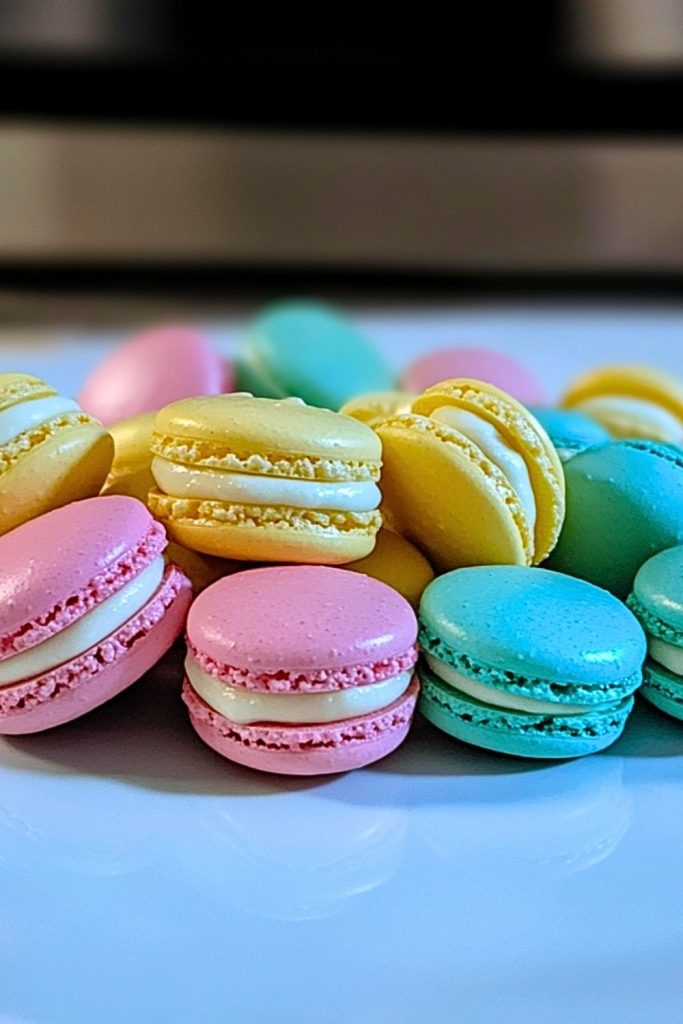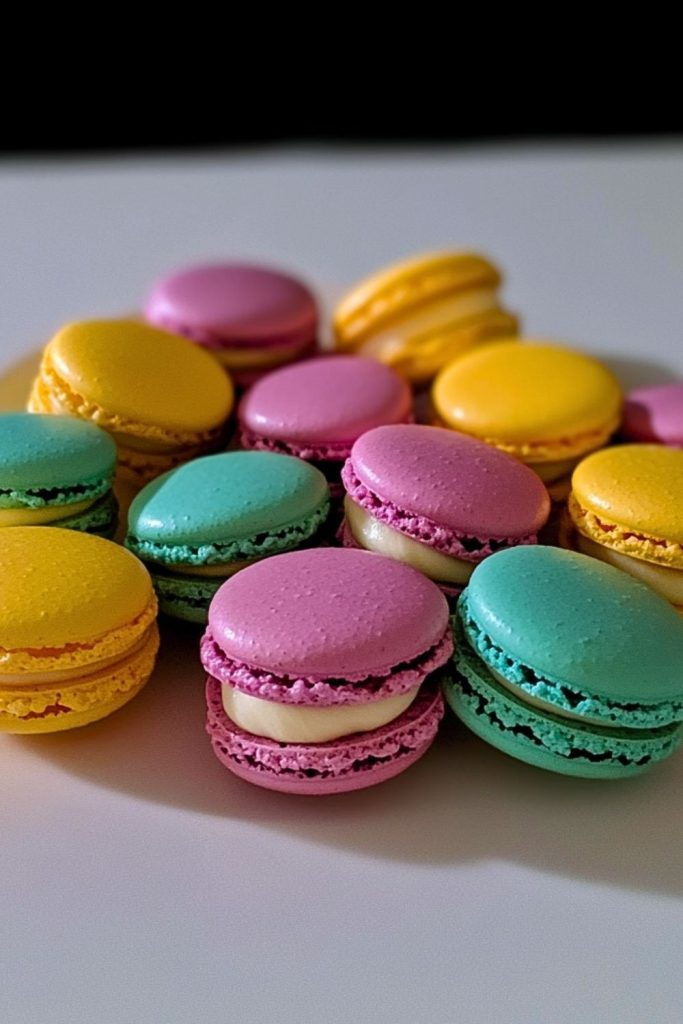Few confections are as enchanting as the delicate French macaron. These little treats, with their crisp outer shells and soft, chewy centers, are the epitome of elegance. Perfect for afternoon tea, gifts, or a colorful addition to any dessert table, macarons offer a delightful bite-sized indulgence.

Though they may seem intimidating at first glance, making macarons at home is entirely achievable, even for beginners. With a few simple techniques and some patience, you can create these colorful gems in your own kitchen. Whether you prefer classic vanilla, vibrant raspberry, or a unique flavor twist, mastering macarons is a rewarding culinary adventure.
Why You’ll Love This Easy Macaron for Beginners
- Beginner-Friendly Approach: This guide is tailored for those new to macaron-making. No complicated techniques—just straightforward steps.
- Minimal Equipment Needed: You don’t need fancy tools to succeed.
- Customizable Flavors & Colors: Match your macarons to any occasion or personal taste.
- Great for Gifting: Homemade macarons make beautiful, thoughtful gifts.
- A Fun Baking Project: Perfect for a weekend bake or a creative kitchen session.
Preparation Phase & Tools to Use
Before diving into the macaron-making process, preparation is key. Setting yourself up with the right tools will ensure smoother steps and better results.
Essential Tools and Equipment & Their Importance
- Kitchen Scale
Precision is vital in macarons. A scale helps measure ingredients accurately—essential for consistent results. - Fine Mesh Sieve
Sifting almond flour and powdered sugar removes clumps and creates a smooth batter. - Electric Mixer (Stand or Handheld)
Whipping egg whites into stiff peaks requires power and consistency. A mixer ensures your meringue forms correctly. - Silicone Baking Mat or Parchment Paper
Prevents sticking and ensures even baking. - Piping Bag with Round Tip
Gives you control when piping uniform rounds of batter onto the baking sheet. - Mixing Bowls (Preferably Metal or Glass)
Clean, grease-free bowls help achieve stable meringue. - Oven Thermometer
Macarons can be finicky about temperature. An oven thermometer ensures your oven is at the correct heat level.
Preparation Tips
- Age the Egg Whites
Separate your egg whites and let them sit in the fridge for 24–48 hours. This helps them whip into a stable meringue. - Sift, Sift, Sift!
Don’t skip sifting the almond flour and powdered sugar—it’s critical for that silky texture. - Work in a Clean Space
Grease can ruin your meringue. Wipe bowls and tools with vinegar to ensure they’re grease-free. - Tap the Tray
After piping, firmly tap your tray on the counter to release air bubbles. This helps avoid hollow shells. - Rest Before Baking
Let the piped macarons rest until they form a dry skin (usually 30–60 minutes). This is key for developing the signature “feet.”
Ingredients for This Easy Macaron for Beginners
Creating beautiful, delicious macarons doesn’t require a long list of ingredients. In fact, simplicity is what makes them so special. Here’s what you’ll need:
For the Macaron Shells
- 100 grams egg whites
Aged for 24–48 hours for optimal stability. - 100 grams granulated sugar
Sweetens and stabilizes the meringue. - 100 grams almond flour (finely ground & blanched)
Provides the signature nutty flavor and structure. - 100 grams powdered sugar
Adds sweetness and helps create a smooth texture. - Gel food coloring (optional)
For vibrant, playful colors. Gel is best to avoid thinning the batter.
For the Filling (Simple Buttercream)
- 100 grams unsalted butter (softened)
Forms the creamy base of the filling. - 150 grams powdered sugar
Sweetens the buttercream. - 1–2 tablespoons milk or heavy cream
Adjusts consistency. - 1 teaspoon vanilla extract (or flavoring of choice)
Adds depth and flavor.

Step 1: Prepare Your Baking Surface
Line baking trays with silicone mats or parchment paper. If you’d like perfectly even shells, you can place a macaron template underneath the parchment and remove it before baking.
Step 2: Sift Dry Ingredients
In a large bowl, sift together almond flour and powdered sugar. Repeat this process at least twice to ensure the mixture is fine and lump-free. Set aside.
Step 3: Whip the Egg Whites
In a clean, grease-free mixing bowl, whip aged egg whites on medium speed. When they start to foam, gradually add granulated sugar. Increase to high speed and continue whipping until stiff, glossy peaks form.
Step 4: Fold in the Dry Ingredients
Add the sifted almond flour and powdered sugar mixture to the meringue in thirds. Gently fold using a spatula—this is called the macaronage process. The batter should flow slowly off the spatula in ribbons and settle back into itself within about 10 seconds.
Step 5: Add Coloring (Optional)
If using food coloring, add it during the final stages of folding to avoid overmixing. Gel or powdered food coloring works best.
Step 6: Pipe the Macarons
Transfer batter to a piping bag fitted with a round tip. Pipe small rounds (about 1.5 inches in diameter) onto the prepared baking sheets, spacing them slightly apart.
Step 7: Tap and Rest
Firmly tap the trays on the counter several times to release any air bubbles. Let the piped macarons rest at room temperature for 30–60 minutes, or until the tops are dry to the touch.
Step 8: Bake
Preheat the oven to 150°C (300°F). Bake one tray at a time in the center of the oven for 14–16 minutes. The macarons should have risen to form “feet” and should not stick to the baking surface.
Step 9: Cool Completely
Allow macarons to cool completely on the tray before removing them. This prevents sticking and cracking.
Step 10: Make the Filling
Beat softened butter until creamy. Gradually add powdered sugar, vanilla extract, and enough milk or cream to achieve a smooth, spreadable consistency.
Step 11: Assemble the Macarons
Pair macaron shells of similar size. Pipe a small dollop of filling onto one shell and gently sandwich with another.
Notes
- Aging Egg Whites
Aging the egg whites improves their elasticity and helps create a stable meringue. Let them rest uncovered in the fridge for 24–48 hours. - Using the Right Almond Flour
Choose finely ground, blanched almond flour. Coarser flour will make your shells grainy. - Color Choices
Gel or powdered food coloring is ideal. Liquid food coloring may thin the batter and affect the texture. - Resting Time Varies
Humidity affects resting time. On humid days, it may take longer for the shells to develop a skin. - Mature for Better Flavor
Macarons taste better after resting for 24 hours in the fridge. The filling and shell meld beautifully over time.
Watch Out for These Mistakes While Cooking
- Over-whipping or Under-whipping the Meringue
Stiff peaks are key. Over-whipping will cause a dry, unstable batter, while under-whipping will make it runny. - Overmixing or Undermixing the Batter
The folding stage is delicate. Overmixing will lead to flat, spread-out shells. Undermixing causes cracked tops. - Skipping the Resting Phase
Without resting, the shells won’t form feet and may crack. - Incorrect Oven Temperature
Too hot? Cracked and browned shells. Too cool? No feet and undercooked centers. Always check your oven with a thermometer. - Opening the Oven Door Too Early
Resist the urge! Opening the oven during the first 10 minutes can cause shells to collapse. - Removing Macarons Before They’re Cooled
Warm shells are fragile and may stick or tear. Let them cool completely.
What to Serve With Easy Macaron for Beginners
Macarons are versatile little confections that pair beautifully with many drinks and desserts. Whether you’re creating an afternoon tea spread or adding them to a dessert table, here are some tasty ideas:
8 Recommendations
1. Tea
A classic pairing! Serve macarons with a pot of Earl Grey, chamomile, green tea, or a delicate white tea to complement their sweetness.
2. Coffee or Espresso
The rich bitterness of coffee balances the sweet, delicate shells. Perfect for a café-style treat.
3. Champagne
Light, bubbly champagne or sparkling wine enhances the elegance of macarons for special occasions.
4. Hot Chocolate
Pair brightly colored macarons with a creamy mug of hot chocolate for a cozy dessert duo.
5. Fruit Platters
Fresh berries, sliced stone fruits, or citrus segments add brightness to the dessert spread.
6. Cheese Boards
For an elegant twist, serve macarons alongside a cheese board with brie, goat cheese, and nuts.
7. Vanilla Ice Cream
Use macarons as a garnish or even a fun topping for scoops of creamy vanilla or fruit-flavored ice cream.
8. Dessert Shooters
Mini dessert parfaits or mousse shooters pair beautifully with macarons placed on top or served alongside.
Storage Instructions
Proper storage is crucial to maintaining the texture and flavor of your homemade macarons.
- Refrigeration
Once filled, macarons should be stored in an airtight container in the refrigerator. Allow them to mature for at least 24 hours—this resting period helps the shells absorb the flavors of the filling and develop the perfect texture. - Shelf Life
Filled macarons will keep well in the fridge for up to 5–7 days. - Freezing
Macaron shells (without filling) can be frozen for up to 1 month. Layer them with parchment paper in an airtight container. When ready to use, allow them to come to room temperature before filling. - Filled Macarons
You can also freeze filled macarons, but results may vary depending on the filling. Buttercream-filled macarons generally freeze well—wrap them tightly and store for up to 1 month.
Estimated Nutrition
Estimated per 1 filled macaron (based on average-sized macaron with buttercream filling):
- Calories: ~90–100 kcal
- Carbohydrates: ~12g
- Sugar: ~10g
- Protein: ~2g
- Fat: ~4g
- Saturated Fat: ~2g
- Fiber: <1g
- Cholesterol: ~10mg
- Sodium: ~10mg
Note: Nutritional values may vary based on filling choices and portion sizes.
Frequently Asked Questions
1. Do I really need to age the egg whites?
While not absolutely required, aging egg whites improves their elasticity and helps create a more stable meringue, resulting in better macaron texture.
2. Why did my macarons crack?
Cracked shells are often caused by under-resting, improper meringue texture, or baking at too high a temperature. Be sure to let the shells form a skin and check your oven temperature.
3. Can I use liquid food coloring?
It’s best to avoid liquid food coloring, as it can thin out the batter. Gel or powdered food coloring is recommended for vibrant color without compromising consistency.
4. How do I know when my meringue is ready?
Your meringue should be thick, glossy, and hold stiff peaks. When you lift the whisk, the peaks should stand straight up.
5. How long should I rest my piped macarons?
Rest until they form a dry skin—typically 30–60 minutes. The surface should not stick to your finger when gently touched.
6. Can I use other fillings besides buttercream?
Absolutely! Ganache, jam, fruit curd, and cream cheese-based fillings are all wonderful options.
7. Why don’t my macarons have feet?
Missing feet are often caused by under-whipped meringue, over-mixed batter, insufficient resting, or incorrect oven temperature.
8. How long do macarons need to mature?
For best flavor and texture, mature filled macarons in the fridge for 24 hours before serving.
Conclusion
Making macarons at home might seem like a challenge, but with a bit of patience and practice, anyone can master these beautiful confections. This Easy Macaron for Beginners guide simplifies the process, helping you avoid common pitfalls and create bakery-worthy results. Whether you’re baking for a special occasion or just for fun, these dainty delights are sure to impress. Now roll up your sleeves, grab your piping bag, and enjoy the magic of macaron-making!

Easy Macaron for Beginners
- Prep Time: 30 minutes
- Cook Time: 14 minutes
- Total Time: 44 minutes
- Yield: Approximately 20–24 filled macarons 1x
Description
This Easy Macaron for Beginners recipe simplifies the art of making classic French macarons. With clear steps and approachable techniques, even novice bakers can achieve crisp, chewy, beautifully filled macarons. Perfect for gifts, parties, or simply treating yourself!
Ingredients
For the Macaron Shells
- 100 grams egg whites (aged 24–48 hours)
- 100 grams granulated sugar
- 100 grams almond flour (finely ground, blanched)
- 100 grams powdered sugar
- Gel food coloring (optional)
For the Filling (Buttercream)
- 100 grams unsalted butter (softened)
- 150 grams powdered sugar
- 1–2 tablespoons milk or heavy cream
- 1 teaspoon vanilla extract (or flavoring of choice)
Instructions
-
Prepare baking sheets with silicone mats or parchment paper.
-
Sift almond flour and powdered sugar together twice. Set aside.
-
Whip egg whites until foamy, gradually adding granulated sugar. Continue whipping to stiff, glossy peaks.
-
Fold dry ingredients into meringue in thirds, using gentle folding until batter flows in ribbons.
-
Add food coloring (if using) near the end of folding.
-
Pipe rounds onto prepared baking sheets.
-
Tap trays to release air bubbles. Rest macarons for 30–60 minutes until tops are dry.
-
Preheat oven to 150°C (300°F).
-
Bake macarons one tray at a time for 14–16 minutes.
-
Cool completely before removing from trays.
-
Prepare buttercream: Beat butter, gradually add powdered sugar, vanilla, and milk/cream until smooth.
-
Assemble macarons: Pipe filling onto one shell and sandwich with another.
-
Mature in fridge for 24 hours for best flavor.

